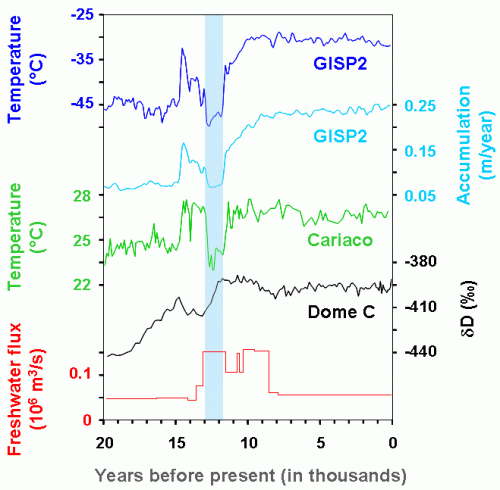August 6, 2013 report
New evidence that cosmic impact caused Younger Dryas extinctions

(Phys.org) —A period of rapid, intense cooling, known as the Younger Dryas, took place about 13,000 years ago. Scientists think this sudden change in climate caused the extinction of many large mammals, such as the mammoth, and was the reason for the disappearance of North America's Clovis people. According to one hypothesis, a cosmic impact caused the climate to cool. Using data from the Greenland ice core, Michail Petaev and his colleagues at Harvard University have found what appears to be evidence of this impact. Their research appears in the Proceedings of the National Academy of Sciences.
Measurements of oxygen isotopes in the Greenland ice core show that around 13,000 years ago an episode of rapid cooling, which lasted only about 1,000 years, occurred. During this time, many megafauna became extinct and evidence of the Clovis people, one of the earliest human societies to inhabit the Americas, disappeared from the archeological record.
According to one hypothesis, a cometary airburst triggered massive wildfires, which caused the climate to cool. Many scientists have rejected this hypothesis, citing lack of sufficient evidence, in favor of others. The most widely accepted one says that during the deglaciation process, fresh water from the proglacial lake Agassiz discharged into the Arctic Ocean, altering ocean currents.
However, Petaev's team says that geomorphological and chronological data do not support this. They claim that evidence for another hypothesis, that the eruption of the Laacher See volcano caused a volcanic winter in the northern hemisphere, is also lacking.
Now, the researchers claim to have uncovered evidence of a cosmic impact at the Younger Dryas boundary. When examining samples from Greenland Ice Sheet Project 2 (GISP2), they found that platinum concentration increased by about 100 times approximately 12,900 years ago.
Platinum/iridium and platinum/aluminum ratios were very high, indicating that the platinum probably did not have a terrestrial source. While most volcanic rocks have high Pt/Ir ratios, their Pt/Al ratios are low. Mantle rocks have low levels of aluminum, but their Pt/Ir ratios are much lower than that measured in the ice core.
On the other hand, Pt/Ir and Pt/Al ratios in magmatic iron meteorites are very high, suggesting that the platinum found in the ice core came from a meteor.
Debris from a cosmic impact would have caused the climate to cool so quickly that species would have been unable to adapt, leading to their extinction. The Clovis people would not have been able to cope with the catastrophic changes to their environment.
The research lends support to recent claims that a sedimentary layer containing iridium grains and glass-like carbon with nanodiamonds, found at many northern hemisphere sites around the Younger Dryas boundary, is evidence of a meteor impact.
Petaev and his colleagues caution that future researchers must locate an impact site in order to confirm this hypothesis.
More information: Large Pt anomaly in the Greenland ice core points to a cataclysm at the onset of Younger Dryas, PNAS, Published online before print July 22, 2013, DOI: 10.1073/pnas.1303924110
Abstract
One explanation of the abrupt cooling episode known as the Younger Dryas (YD) is a cosmic impact or airburst at the YD boundary (YDB) that triggered cooling and resulted in other calamities, including the disappearance of the Clovis culture and the extinction of many large mammal species. We tested the YDB impact hypothesis by analyzing ice samples from the Greenland Ice Sheet Project 2 (GISP2) ice core across the Bølling-Allerød/YD boundary for major and trace elements. We found a large Pt anomaly at the YDB, not accompanied by a prominent Ir anomaly, with the Pt/Ir ratios at the Pt peak exceeding those in known terrestrial and extraterrestrial materials. Whereas the highly fractionated Pt/Ir ratio rules out mantle or chondritic sources of the Pt anomaly, it does not allow positive identification of the source. Circumstantial evidence such as very high, superchondritic Pt/Al ratios associated with the Pt anomaly and its timing, different from other major events recorded on the GISP2 ice core such as well-understood sulfate spikes caused by volcanic activity and the ammonium and nitrate spike due to the biomass destruction, hints for an extraterrestrial source of Pt. Such a source could have been a highly differentiated object like an Ir-poor iron meteorite that is unlikely to result in an airburst or trigger wide wildfires proposed by the YDB impact hypothesis.
Journal information: Proceedings of the National Academy of Sciences
© 2013 Phys.org


















